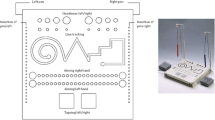Abstract
Writer's Cramp is a functional motor disorder classified as an occupational neurosis included under ICD-9 and under Other specified neurotic disorders of uncertain etiology in ICD-10. It is exhibited while writing in the form of spasms, in-coordination, pain, stiffness , and tension in muscles of fingers and hand of the writing arm; often spreading to lower and upper arm and subsequently to shoulder girdle. In India it has been reported to be 5.4 per thousand among office workers in urban settings. It has been treated differently by neurologists, psychiatrics and psychologists depending upon their views on its genesis. Psychological intervention tends to involve therapeutic packages ranging from 20 to 50 sessions with elements from relaxation, conditioning, reinforcement schedules and 'supinator' writing with abstinence from writing during the implementation of regime. The present paper discusses the successful treatment of writer's cramp with brief cognitive behavior management without any restrictions on writing
Similar content being viewed by others
References
Bindman, E., & Tibbetts, R. W. (1977). Writer’s cramp-a rational approach to treatment. British Journal of Psychiatry, 131, 143–148.
Crisp, A. H., & Moldofsky, H. (1965). A psychosomatic study of writer's cramp. British Journal of Psychiatry, 111, 841–858.
Gowers, W. R. (1904). Lumbago: its lessons and analogues. British Medical Journal, 1, 17–2 1.
John, J., Roy, A., Mohammed, S., Joseph, G., & Verghese, A. (1984). Treatment of writers cramp: a follow up study. Indian Journal of Psychiatry, 26(4), 364–369.
Lim, V. K., Altenmuller, E., & Bradshaw, J. L. (2001). Focal dystonia: current theories. Human Movement Science, 20, 875–914.
Schenk, T., Bauer, B., Steidle, B., & Marquardt, C. (2004). Does training improve writer's cramp? An evaluation of a behavioral treatment approach using kinematic analysis. Journal of hand therapy, 17(3), 349–363.
Shavlovskaia, O. A., Orlova, O. R., Golubev, V. L., et al. (2002). Clinical and physiological analysis and treatment of writer's cramp. Zh Nevrol Psikhiatr Im S S Korsakova, 102(10), 35–41.
Author information
Authors and Affiliations
Corresponding author
Rights and permissions
About this article
Cite this article
Kaur, H., Kaur, P. Management of Writer’s Cramp. Psychol Stud 57, 37–39 (2012). https://doi.org/10.1007/s12646-011-0117-7
Received:
Accepted:
Published:
Issue Date:
DOI: https://doi.org/10.1007/s12646-011-0117-7




